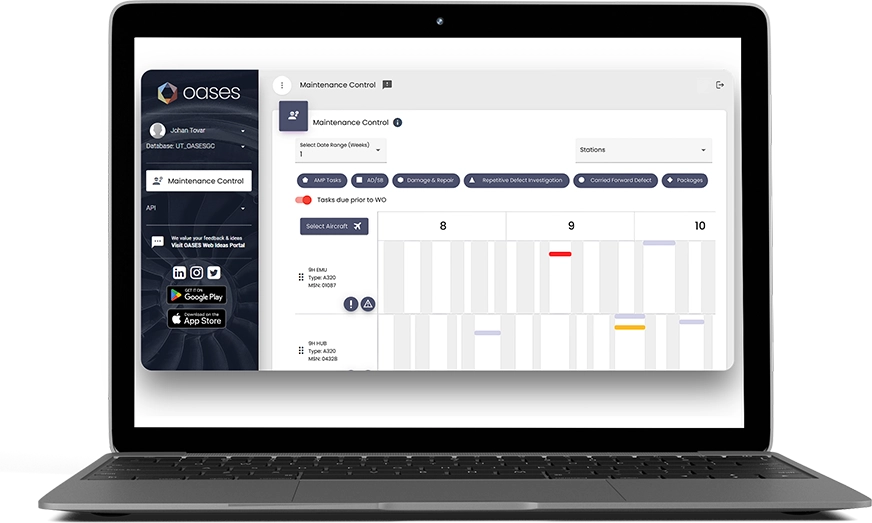Harvesting and utilising the vast amounts of data produced by modern aircraft – Part 1
The aviation industry is constantly evolving, adapting to new technologies and innovating to improve efficiency, customer experience and – most importantly – safety. One of the most significant advancements has been the development of intelligent algorithms that provide valuable insights into aircraft performance.
Newer aircraft are now fitted with many thousands of sensors, providing airlines with an unprecedented amount of data on everything from engine performance to tire pressure to cabin temperature.
Some aircraft (such as the Airbus A350) produce data for up to 400,000 parameters, and the Boeing 737 generates 20 Terabytes of engine data every single hour – not to mention the volumes generated by sensors throughout rest of the aircraft.
By harnessing this data, aviation companies can predict maintenance needs to prevent unplanned downtime and even improve fuel efficiency. This two-part series will explore what type of data aircrafts generate with each flight, how we can use that data, and what developments we can expect in the future regarding big data in aviation.
A Brief History of Big Data in Aviation
The use of data in the aviation industry is nothing new and we’ve come a long way since the Wright Brothers hand-wrote pilot logs for the first flights. The Air Commerce Act of 1926 then made it compulsory to keep detailed aircraft techlogs, including details such as fuel levels, oil levels, and defects that occurred during each flight. Another key milestone was the digitisation of technical logs that connect with maintenance systems.
The automation of data collection and transmission took things a step further, allowing for more comprehensive datasets to be gathered. In the past, snapshots of the aircraft’s condition were recorded and transmitted at certain intervals during the flight. These days, however, the data is continuously recorded throughout, in some cases with snapshots being taken every second. This became possible thanks to improved transmission bandwidth.
Newer aircraft are also fitted with a much greater number of sensors than before, and cloud technology allows for the storage of staggering volumes of data. Increased processing power also makes it possible to analyse this data in near real-time.
Rolls-Royce have been influential in big data since the 1990s when they developed their engine health monitoring systems. As these systems continue to advance, sensors are deployed in new areas of the engines, providing even more robust monitoring. In fact, they expect to handle 20 billion data points per day in the future.
The Benefits of Collecting and Analysing Aircraft Data
Some of the key benefits of collecting and analysing aircraft data include:
- Safety: The most important benefit, airlines can identify potential safety issues before they become critical.
- Improved fuel efficiency: By analysing data on fuel consumption and engine performance, organisations can identify areas for optimisation and reduce the amount of fuel used on each flight, reducing costs and reducing the environmental impact of flight.
- Improved customer experience: By minimising unplanned downtime, flights can leave on time, ensuring the end customer is satisfied.
- Compliance: By collecting data and managing it using a system such as OASES, airlines can more easily comply with airworthiness regulations.
- Streamlined fleet operations: The management of entire fleets becomes much more efficient thanks to the collection and management of aircraft data.
What Data Do Aircraft Generate?
Just a few of the numerous parameters monitored regarding engine function include:
- Vibration
- Temperature
- Speed and torque
- Noise
- Electrical currents
- Ice detection
- Fuel properties
- Exhaust gas composition
- Gas path debris
- Mass flows
Some aircraft have as many as 10,000 sensors on each wing alone, gathering data on load, strain, ice detection, and so on. Sensors are found across the fuselage, inside the cabin to monitor passenger behaviour, on the tyres – virtually everywhere.
Technical data may also be combined with data on external factors such as weather, flight routes, fuelling, and so on; conducting multivariate analyses on all these variables can provide detailed insights on how they influence one another.
What Insights Are Possible with Big Data in Aviation?
Data analytics is transforming aircraft maintenance by enabling airlines to move from reactive to proactive maintenance. Waiting for a component to fail before repairing or replacing it is costly, time-consuming, and a safety risk.
On the other hand, predictive maintenance uses data analytics to forecast when a component is likely to fail so it can be replaced it before it causes a problem. Potential issues are therefore identified before they become critical, ensuring passenger safety and reducing downtime.
Here’s another example – suppose a fault is detected during flight; the destination airport can be contacted with the message that the part in-question needs looking at. Engineers can then be allocated ahead of time (before the plane has landed), ensuring that the issue is addressed as swiftly as possible on arrival. Some systems will allocate engineers automatically, further enhancing efficiency.
An example discussed by GE is the monitoring of oil consumption in engines used in Boeing 777s. On one occasion, data on the oil levels before and after flights showed an unexpected increase in oil consumption, and the analysts were able to discover that it was caused by a loose v-nut on an oil-feed tube. This allowed for quick intervention before service could be disrupted.
The use of data to improve fuel efficiency and reduce emissions has become increasingly important as airlines strive to meet stringent emissions regulations. This need is confounded by the increase in fuel prices in recent years. Thankfully, predictive maintenance helps to improve fuel efficiency through the early detection of issues such as leaky valves and ducts, which adds up to significant savings at-scale.
Purchasing spares is another area of inefficiency that analytics helps to solve. If there were no predictive maintenance, there would be no way to know whether a part needed replacing and as a result, a large number of spares would have to be available to cover all contingencies at all times. This blanket approach means purchasing and storing a large number of parts that are not actually required.
Instead, predictive maintenance allows for leaner operations where parts are acquired as and when needed.
Combining big data with drones and other AI applications that are making their way into the industry, aviation will become safer than ever before.
Conclusion
Big data in aviation has come a long way in recent years, enhancing safety, efficiency, and customer experience. Modern aircraft are fitted with thousands of sensors that collect data continuously throughout a flight, providing a comprehensive overview of the condition of every essential system in every moment. Thanks to cloud technology, the endless Terabytes of data can be stored and processed.
Predictive analytics allows airlines and MRO providers to be ready to respond in real-time, allocating engineers where needed before the plane has landed. This reduces downtime and ensures flights remain on-schedule.
Collecting data is only the first part of a complex process. These huge volumes of raw data need to be managed and organised so that insights can be extracted – and we’ll be discussing this in part 2.
For now, discover how OASES can streamline your MRO processes, enhance safety, and ensure continuing airworthiness – get in contact today to book a demo.
To learn more or book an OASES demo, contact us today
For organisations looking to ascend to new heights of operational excellence, contact us today to book a demo.



